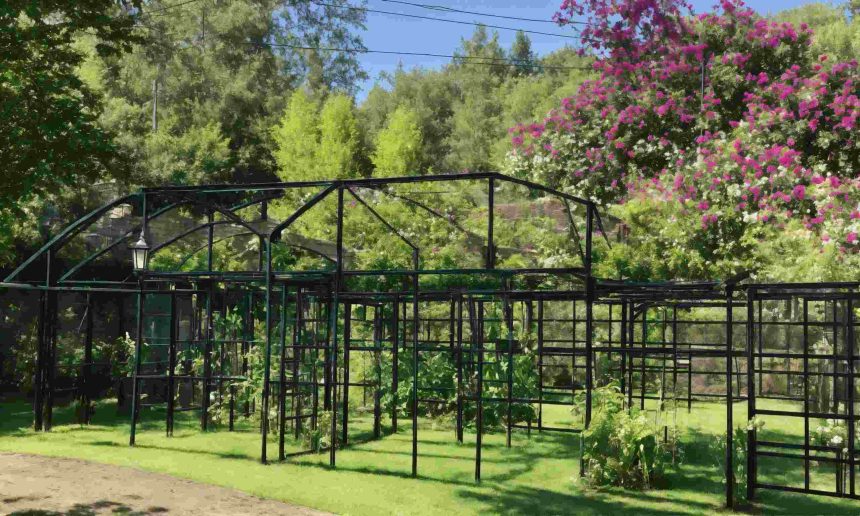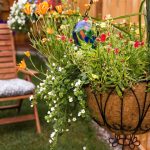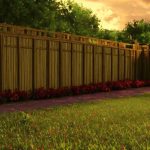As a passionate gardener, you know that providing your plants with the right support is crucial for their growth and overall health. Plant supports not only help your plants grow vertically, but they also prevent them from falling over, protect them from damage and even increase the aesthetic appeal of your garden.
Why Use Plant Supports in Your Garden?
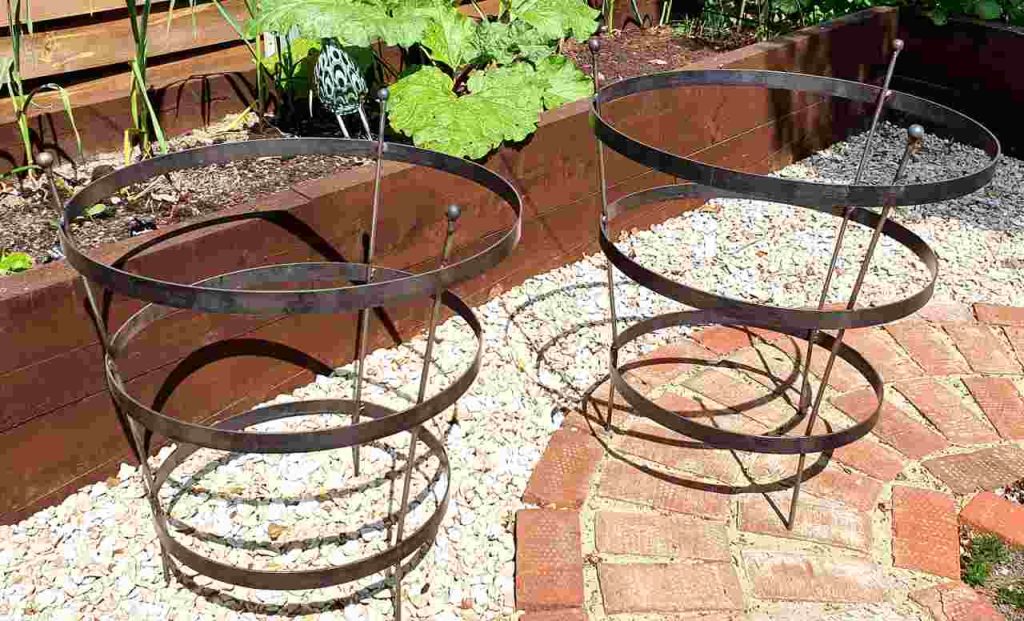
- Vertical Growth: Many plants, such as climbing vines and tall flowers, naturally grow vertically. Plant supports provide them with the structure they need to grow upwards, maximizing your garden space.
- Prevention of Damage: Without proper support, plants can easily fall over, especially during strong winds or heavy rain. This can lead to broken stems, damaged leaves and even uprooted plants. Plant supports keep your plants secure and prevent such damage.
- Improved Air Circulation: When plants are supported and grow vertically, it improves air circulation around them. This helps prevent fungal diseases and pest infestations, which thrive in damp, crowded conditions.
- Enhanced Aesthetics: Plant supports add a decorative element to your garden. They can create stunning vertical displays, define garden sections and even serve as focal points.
- Easier Maintenance: With plant supports, gardening tasks such as pruning, watering and harvesting become much easier. You can access your plants more easily and they are less likely to tangle with neighboring plants.
Types of Plant Supports

1. Trellises
Trellises are one of the most popular plant supports, perfect for climbing plants like roses, clematis and jasmine. They come in a variety of materials, sizes and designs to suit different plants and garden styles.
Wooden Trellises
Wooden trellises are classic and versatile, offering a natural and rustic look. They can be freestanding or attached to walls or fences. You can choose from pre-made designs or build your own using lattice panels, poles and wires.
Pros:
- Natural and attractive appearance
- Durable and long-lasting, especially when treated with weather-resistant finishes
- Easy to customize and build yourself
Cons:
- Can be expensive, especially for larger or intricate designs
- May rot or warp over time if not properly maintained
Metal Trellises
Metal trellises, made from materials like steel or wrought iron, provide sturdy support for heavier climbing plants. They offer a more modern and ornate look compared to wooden trellises.
Pros:
- Strong and durable, able to support heavy plants
- Weather-resistant and low-maintenance
- Available in various decorative designs
Cons:
- Can be more expensive than wooden trellises
- May rust over time if not properly coated or maintained
Plastic Trellises
Plastic trellises are lightweight, affordable and easy to install. They are perfect for smaller gardens or for supporting lightweight climbing plants.
Pros:
- Lightweight and easy to handle
- Affordable and widely available
- Weather-resistant and low-maintenance
Cons:
- May not be as sturdy as wooden or metal trellises
- Limited design options compared to other materials
2. Cages and Stakes
Cages and stakes are ideal for supporting tall, bushy plants like tomatoes, peppers and perennials. They keep the plants upright and prevent them from sprawling on the ground.
Tomato Cages
Tomato cages are cylindrical supports that surround the plant, allowing it to grow within the cage. They are typically made from metal wire or plastic and come in various sizes to accommodate different tomato varieties.
Pros:
- Easy to install and remove
- Provide good support for bushy tomato plants
- Allow for easy harvesting of fruits
Cons:
- May not be tall enough for indeterminate tomato varieties
- Can be flimsy and prone to toppling over if not properly secured
Stake and Tie
The stake and tie method involves inserting a tall stake next to the plant and tying the plant to the stake as it grows. This method is suitable for plants with a central stem, like peppers and eggplants.
Pros:
- Inexpensive and easy to set up
- Allows for customizable support based on the plant’s growth
- Takes up minimal space in the garden
Cons:
- Requires regular tying and adjustment as the plant grows
- May not provide enough support for heavy or bushy plants
3. Arches and Arbors
Arches and arbors are decorative plant supports that create stunning vertical displays and define garden spaces. They are perfect for climbing plants like roses, wisteria and grapevines.
Garden Arches
Garden arches are freestanding structures that create a walkway or entrance in your garden. They can be made from various materials like metal, wood or plastic and come in different styles to match your garden theme.
Pros:
- Create a beautiful focal point in the garden
- Provide sturdy support for climbing plants
- Can define garden sections or create a welcoming entrance
Cons:
- Require a larger footprint in the garden
- Can be expensive, especially for larger or more ornate designs
Arbors
Arbors are similar to garden arches but typically have a roof-like structure on top, providing shade and a seating area beneath. They are perfect for creating a cozy retreat in your garden.
Pros:
- Provide both plant support and a shaded seating area
- Increase the overall aesthetic of the garden
- Offer a sturdy and long-lasting structure
Cons:
- Require a significant amount of space
- Can be costly, especially for larger or more intricate designs
4. Obelisks and Teepees
Obelisks and teepees are pyramid-shaped plant supports that offer a unique and attractive way to display climbing plants or tall flowers.
Obelisks
Obelisks are tall, four-sided structures that taper towards the top, resembling a pyramid. They are typically made from metal or wood and can be used to support climbing plants or as a decorative feature in the garden.
Pros:
- Add height and visual interest to the garden
- Provide sturdy support for climbing plants
- Can serve as a focal point or sculpture in the garden
Cons:
- May be more expensive than other plant supports
- Require a larger footprint in the garden
Teepees
Teepees are simple structures made by tying several long poles or stakes together at the top, forming a cone shape. They are perfect for supporting tall, vining plants like pole beans or sweet peas.
Pros:
- Inexpensive and easy to make using bamboo poles or wooden stakes
- Provide good support for tall, vining plants
- Add a rustic and natural look to the garden
Cons:
- May not be as sturdy as other plant supports
- Require tying and adjustment as the plants grow
Choosing the Right Plant Support
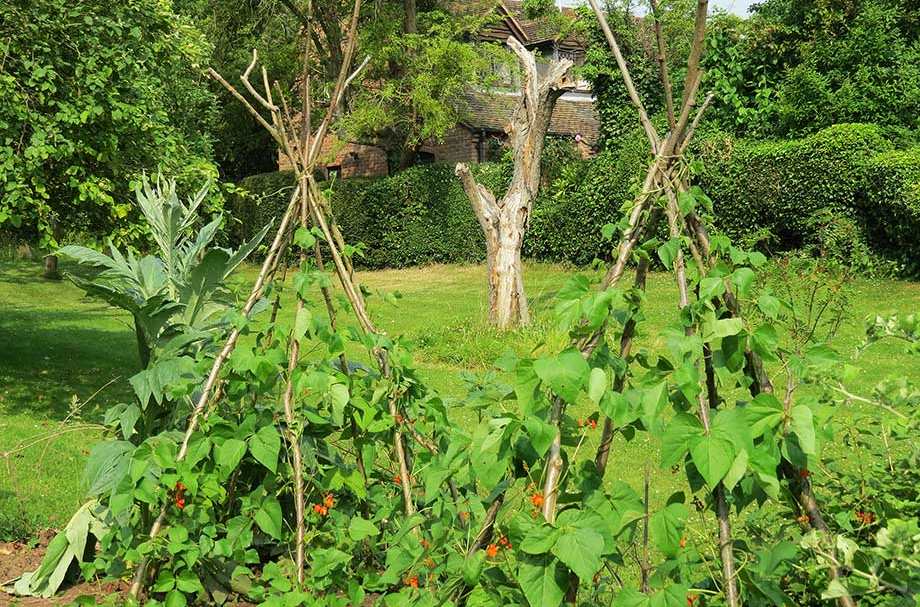
- Plant Type: Consider the growth habit and size of the plant you want to support. Climbing plants like vines will require tall, sturdy supports like trellises or arches, while bushy plants like tomatoes may benefit from cages or stakes.
- Garden Style: Choose a plant support that complements your garden’s overall style and theme. For a formal garden, ornate metal trellises or arches may be appropriate, while a rustic garden may benefit from wooden obelisks or teepees.
- Available Space: Consider the amount of space you have in your garden and choose a plant support that fits within that space. Trellises and arches require more room, while stakes and cages have a smaller footprint.
- Budget: Plant supports come at various price points, from inexpensive stakes to costly metal arbors. Determine your budget and choose a support that fits within your means. Remember, you can always start with simple supports and upgrade later as your garden grows.
- Durability: Consider the material and construction of the plant support. Choose supports that are sturdy, weather-resistant and able to withstand the weight of mature plants. Investing in high-quality supports will save you money in the long run, as they will last longer and require less replacement.
DIY Plant Supports
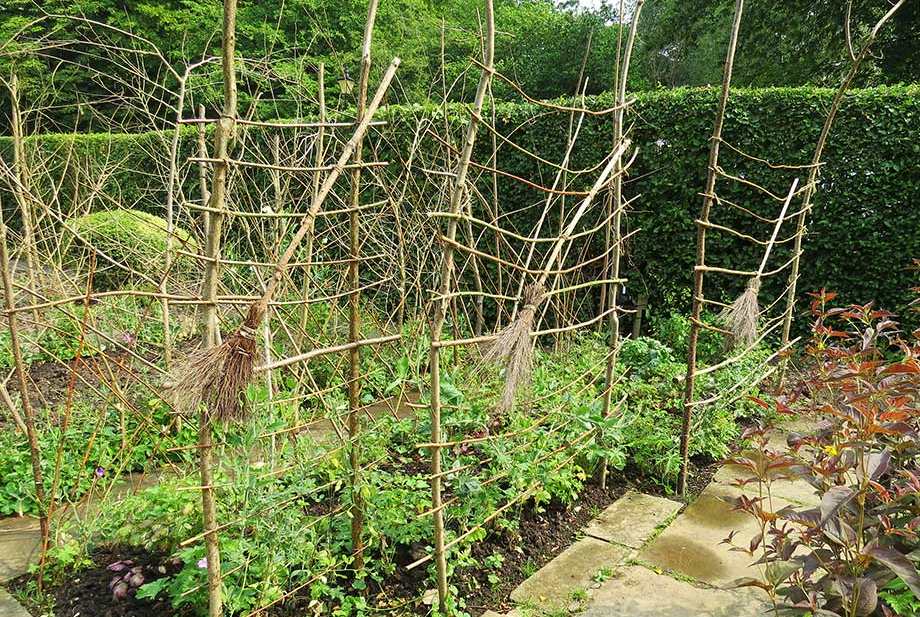
Bamboo Teepees
To make a simple bamboo teepee, gather several bamboo poles of equal length (at least 6 feet long). Tie the poles together at one end using twine or zip ties, spreading the poles out to form a teepee shape. Anchor the teepee in the ground by pushing the poles into the soil.
Upcycled Trellis
Repurpose old items like ladders, bed frames or wooden pallets to create a unique and eco-friendly trellis. Simply secure the item in the ground and use twine or wire to create a lattice pattern for your plants to climb.
Stake and String Support
For a simple and adjustable plant support, drive tall stakes into the ground around your plant. As the plant grows, tie strings between the stakes at various heights, creating a web-like support system.
PVC Pipe Arch
Create an inexpensive garden arch using PVC pipes. Cut the pipes to your desired length and connect them using PVC connectors to form an arch shape. Anchor the arch in the ground using rebar or stakes and use twine or wire to create a lattice for your plants to climb.
Maintenance and Care
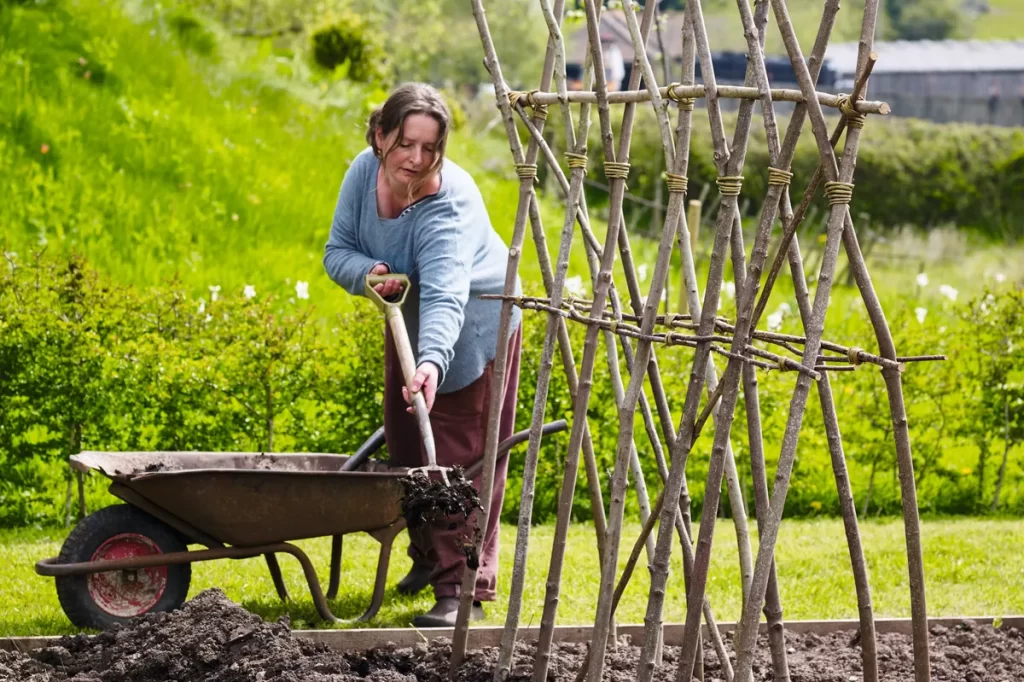
- Inspection: Regularly inspect your plant supports for signs of damage, rust or rot. Check for loose connections or sagging structures and make repairs as needed.
- Cleaning: Remove any dead foliage or debris from your plant supports to prevent disease and pest issues. Wipe down metal or plastic supports with a damp cloth to remove dirt and grime.
- Painting or Staining: To extend the life of wooden supports, apply a fresh coat of paint or stain every few years. This will protect the wood from weather damage and keep it looking attractive.
- Proper Storage: At the end of the growing season, remove any temporary plant supports and store them properly. Clean them thoroughly and keep them in a dry, protected area until the next season.
FAQs
The needed height depends on the mature size of the plant variety. Smaller vegetables and flowers may only need supports 3-4 feet tall, while indeterminate tomato varieties can grow over 5 feet. Check plant tags or seed packets for recommendations.
Most flowers and smaller vegetables only need a single stake next to each stem. Vining plants like tomatoes, pole beans, peas and cucumbers benefit from trellises and fences shared by multiple plants.
Use soft tie material and loose bindings so stems are not cut or constricted. Periodically check ties and resecure plants to allow for growth. Wrap sharp wire ends in tape. Locate stakes and cages carefully to avoid damaging roots.
Temporary stakes and trellises can usually be removed at the end of the growing season if they will not damage established root zones or perennials. Biodegradable supports can be cut off at soil level and allowed to decompose.
Definitely! Clean stakes, cages, poles and trellises at season end to store for reuse. Exceptions would be supports that become cracked or rotten over time. Most supports will last for many years in the garden.
Conclusion
Plant supports are an essential tool for every gardener, providing the necessary structure and support for plants to thrive. By understanding the various types of supports available and how to choose the right ones for your garden, you can create a beautiful and healthy green space. Whether you opt for classic trellises, sturdy cages or decorative arches, your plants will thank you for the support.
Remember, investing in high-quality plant supports and maintaining them regularly will ensure your garden remains beautiful and productive for years to come. So, get out there and start supporting your plants – your garden will be the envy of the neighborhood!
Read More
Best Hanging Basket Ideas for Home Decor


